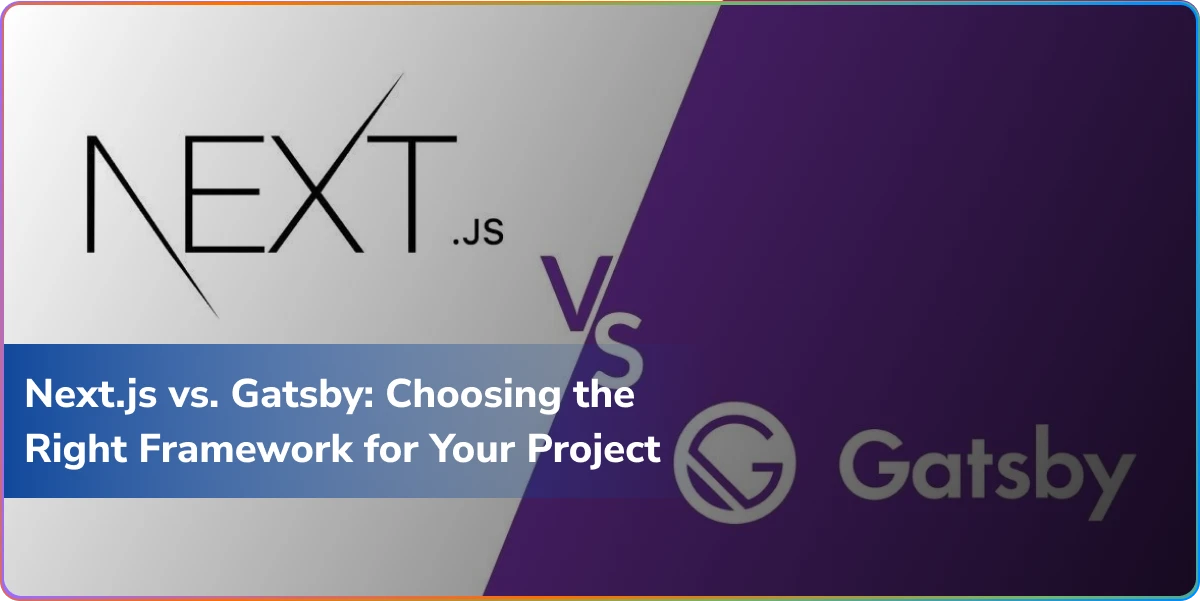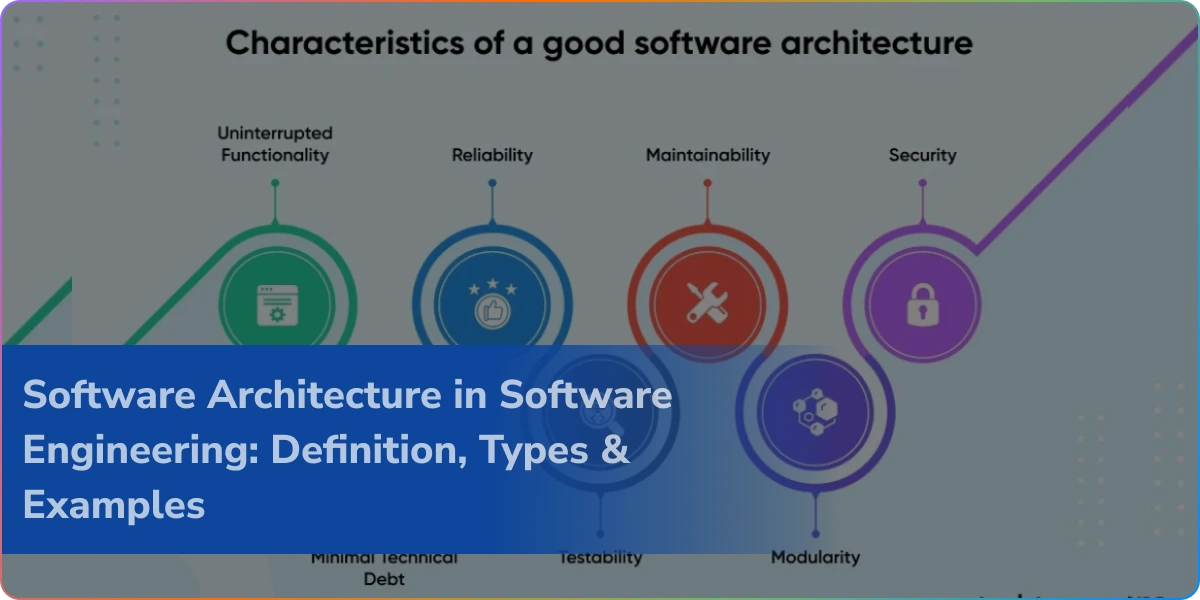Developers and Companies who aim to build a robust website or app are always seeking the best framework for development that would garner optimum benefits for the audience as well as bring profits for the company. When it comes to web development in today’s era, the discussion of Next.js vs. Gatsby is common among developers. Both are built with robust features for developing quick, optimized, and scalable websites. They serve different purposes, though. In this blog, we will discuss the Next.js and Gatsby similarities, differences, uses, and more for you to decide which is better: Next.js or Gatsby?
Understanding Next.js and Gatsby
Let us briefly understand what each framework offers and where it is used.
What is Next.js?
Next.js is a React framework that offers server-side rendering (SSR) and static site generation (SSG). It is mostly used for the development of high-performance, dynamic applications that are SEO-optimized, integrate APIs, and load real-time data. Netflix, Uber, and Twitch utilize Next.js due to its scalability and flexibility.
Example: When you’re creating an e-commerce site such as Amazon, where prices and availability change often, Next.js enables you to fetch and display data in real time without needing a full site rebuild.
What is Gatsby?
Gatsby is another React-based framework but for static site generation (SSG). It uses GraphQL to make data fetches during build time and is thus a great option for sites with a lot of content, blogs, and marketing websites. Gatsby’s ecosystem supports a huge array of plugins that boost performance as well as functionality.
Example: If you’re building a personal blog such as a travel diary or portfolio site, Gatsby pre-renders all the pages so that the loading speed is instant, giving the user a great experience without the need for real-time updates.
Key Differences Between Next.js and Gatsby
Let’s understand Next.js Gatsby differences as per various factors:
1. Performance
- Next.js: Provides server-side rendering (SSR), static site generation (SSG), and incremental static regeneration (ISR), which is best suited for websites that need constant updates.
- Gatsby: Pre-builds every page at compile time, which is good for quick page load times but bad for the build time for massive sites.
Example: A news site like BBC News could utilize Next.js since it can dynamically load breaking news updates without needing to rebuild the whole site. Conversely, a company landing page that only updates the occasional content would suit Gatsby better.
2. Data Fetching
- Next.js: Supports several data-fetching approaches, such as SSR, SSG, ISR, and client-side fetching, offering flexibility depending on the project’s needs.
- Gatsby: Utilizes GraphQL to fetch data at build time, restricting dynamic content updates without re-building the site.
Example: A real estate portal site that updates property listings constantly would need Next.js to rebuild listings dynamically without having a full rebuild. An oven recipe blog that has less frequent content updates could employ Gatsby.
3. SEO Capabilities
- Next.js: Great for SEO because of SSR and hybrid rendering, which allows search engines to index new content in a timely manner.
- Gatsby: SEO-friendly with static pages, but real-time updates need extra configurations.
Example: A health website providing daily health news would do well with Next.js so Google can index fresh information. A wedding photographer portfolio would be great with Gatsby, since the content is static.
4. Ease of Development
- Next.js: Offers a simple, flexible way with API routes, middleware, and routing based on files.
- Gatsby: Demands a templated GraphQL implementation, which might be a hurdle for newbies.
Example: A company creating an MVP of an AI-based chatbot will find Next.js more versatile as it works in harmony with back-end APIs. In contrast, a restaurant site with static menus and addresses could deploy Gatsby for rapid deployment.
5. Build and Deployment
- Next.js: Provides support for on-demand rendering and plays nicely with Vercel and Netlify, among others.
- Gatsby: Best suited for static site hosting and performs optimally on JAMstack frameworks.
Example: A price plan, feature, and user dashboard update often subscription-based SaaS application would be best suited for Next.js. A corporate event microsite that has to load fast and perhaps not often update would be a better fit for Gatsby.
6. Community and Ecosystem
- Next.js: Supported by Vercel, with a maturing ecosystem and strong community backing.
- Gatsby: Rich plugin ecosystem, but potentially behind on long-term support than Next.js.
Example: If you are building an enterprise-level solution on a large scale, Next.js is a safer bet due to its constant updating and extensive use. Yet, for a non-profit blog or educational website, Gatsby is excellent in performance and maintenance costs.
Want to hire expert developers to integrate NextJS or Gatsby for your next web development project? Connect with us today.
Rendering Methods Comparison Between Next.js and Gatsby
One of the main differences between Gatsby and Next.js lies in how they deal with rendering. Knowing their ways of rendering can assist you in making the best choice.
Next.js Rendering Methods:
- Server-Side Rendering (SSR): Renders pages dynamically when asked for.
- Static Site Generation (SSG): Pre-compiles pages at compile time to support high-speed performance.
- Incremental Static Regeneration (ISR): Supports refreshing static pages post-deployment.
- Client-Side Rendering (CSR): Dynamically renders pages within the browser once data is fetched from APIs.
Gatsby Rendering Methods:
- Static Site Generation (SSG): Gatsby generates static HTML during compilation time, resulting in lightning-fast page loads.
- Deferred Static Generation (DSG): Enables specific pages to be constructed only upon demand, allowing for build time optimization on large sites.
- Client-Side Rendering (CSR): Utilized for dynamic components that load data during runtime.
Example: When building a live stock market dashboard, Next.js SSR or ISR would be most appropriate so users see the latest data at all times. Nonetheless, a non-dynamic portfolio website that infrequently needs updating would be better with Gatsby’s SSG
Next.js vs Gatsby – Plugins and Ecosystems Comparison
Both Next.js and Gatsby come with large ecosystems of integrations and plugins that extend their feature sets.
- Next.js Integrations & Plugins: Next.js takes a minimalistic route, but it integrates very well with third-party services such as CMSs (Contentful, Strapi, Sanity), authentication providers (Auth0, Firebase), and API endpoints. As Next.js is more dynamic, developers create custom integrations rather than using a large plugin library.
- Gatsby Plugins: Gatsby boasts a rich plugin ecosystem, enabling developers to seamlessly introduce functionality such as image optimization (gatsby-plugin-image), SEO plugins, CMS content sourcing from WordPress or Drupal, and progressive web app (PWA) support. These plugins render Gatsby extremely convenient for static sites with pre-defined functionality.
Example: If you are creating a headless WordPress blog, Gatsby’s vast plugin support allows for simple fetching and rendering of WordPress content. Alternatively, if you require real-time user authentication through Firebase, Next.js would be more appropriate because of its API and server-side support.
Which is Better: Next.js or Gatsby?
The answer depends on your project requirements:
- Select Next.js when you require dynamic content, API integration, SSR, and live updates.
- Select Gatsby if you want pre-configured static sites with quick performance and little server expense.
When to Use Next.js
- Dynamic pricing and inventory e-commerce websites.
- Web applications involving user authentication and API calls.
- News sites or blogs that require regular content refreshing.
Example: A video streaming and real-time quiz-based customized online learning platform is more appropriate for Next.js because it can efficiently manage dynamic updates of content.
When to Use Gatsby
- Company landing pages and marketing websites.
- Simple blogs with few real-time updates of data.
- High-performance and SEO-centric portfolio websites.
Example: A public speaker’s personal brand website featuring a biography, reviews, and event calendars can leverage Gatsby’s quick static page loading.
Conclusion
Both Next.js vs. Gatsby have their advantages. Your project depends on the complexity, scalability, and performance requirements. Understanding the Next.js and Gatsby differences will help you make a clear decision about what is best: Next.js or Gatsby? for your upcoming web development project.
Need help from experts? Our developers at Logixbuilt Solutions have expertise in Next.js and Gatsby to develop high-performance web solutions according to your requirements. Get in touch with us today!
FAQ
- What‘s the primary distinction between Next.js and Gatsby?
Next.js has SSR, SSG, and ISR support, which makes it perfect for dynamic websites. Gatsby specializes in SSG, which loads quickly but leads to rebuilds upon updates.
- Which is the most preferred SEO, Next.js or Gatsby?
Next.js is perfect for dynamic SEO using SSR, whereas Gatsby is ideal for static SEO with additional steps needed for frequent updates.
- When would I use Next.js instead of Gatsby?
Use Next.js for real-time data, e-commerce, and SaaS applications. Use Gatsby for blogs, portfolios, and static websites.
- Does Gatsby support dynamic content?
Yes, through client-side rendering (CSR), but Next.js provides greater flexibility with SSR and ISR for real-time updates.
- How can Logixbuilt Solutions assist you in project development?
We develop high-performance web applications with Next.js and Gatsby, providing speed, SEO, and scalability.



